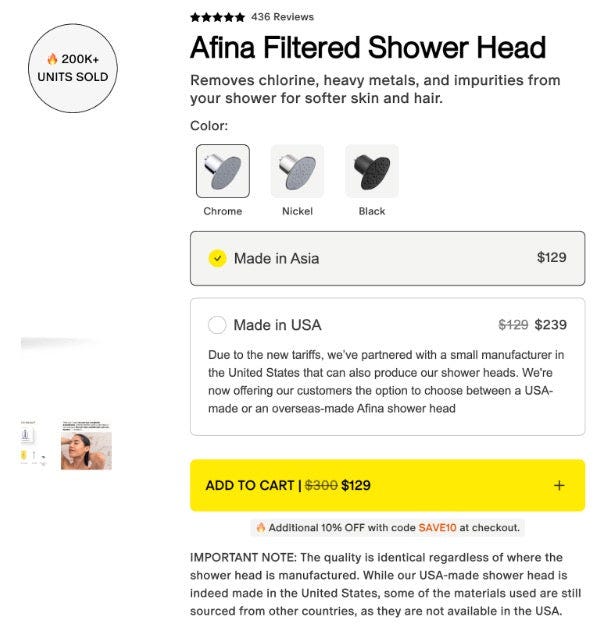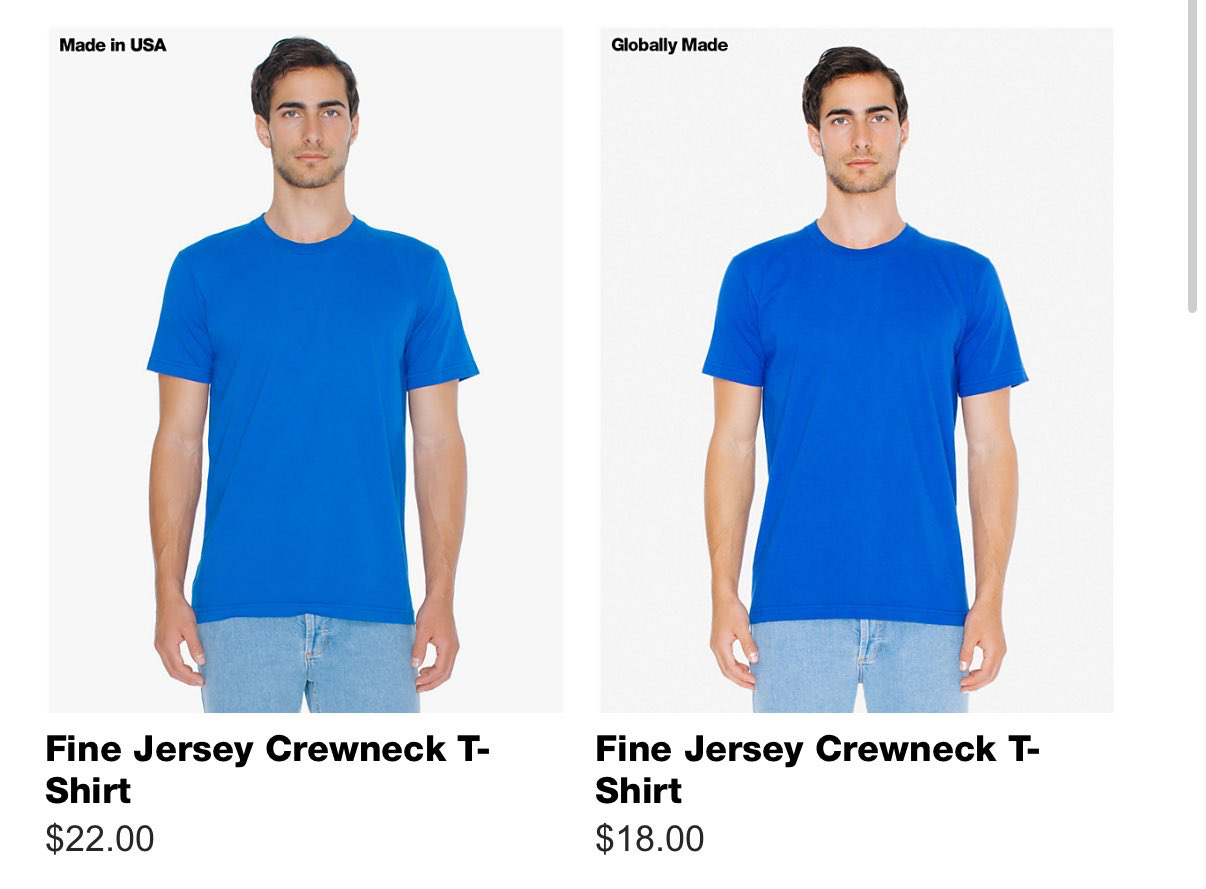3BI: "Weak-Link" sports, Humanities and AI, "Made in the USA" premium
Welcome to my 3BI newsletter, where I share three insights from the world of behavioral science on psychology, decision-making, and behavioral change.
Did someone forward this newsletter to you? Sign up here to have every new edition delivered straight to your inbox.
Will consumers pay more for “Made in the USA?”
In a vacuum, many people will say that they prefer to buy American made products, but does that align with their actual actions? Companies have run experiments to answer that exact question.
Recently, Afina, a startup selling filtered showerheads, ran an experiment on their best-selling model to evaluate if they could reshore its manufacturing to the U.S. while maintaining margins. They created a landing page with identical products and designs, but with one labeled “Made in Asia” and priced at $129, and another “Made in the USA,” at $239.
The results were stark: over 3,500 bought the cheaper, Asia-made version while no one bought the U.S. version.
Perhaps that isn’t surprising when the cost difference is so drastic, but similar experiments using lower cost items yielded similar results.
In 2017, American Apparel rolled out two identical versions of some of its top-selling items. They sold a "Made in USA" version next to a "Globally Made" version, which was mostly made in the company's Honduras manufacturing location. The only difference was that the "Made in USA" versions cost approximately 17% to 26% more due to the higher cost of production in the U.S.
The exact results of the experiment aren’t publicly available, but the "Made in USA" line quietly disappeared from American Apparel's offerings within two years of its launch, suggesting that consumer demand was too low to justify the effort.
This isn’t unique to “Made in America” products. Consumers show time and time again that economics are more important than values in their purchasing decisions, as similar findings show up in everything from sustainability to social issues. There is a desire for purchases to reflect values, but only if the price is right.
The “Weak Link” Era of the NBA
In their 2011 book The Numbers Game: Why Everything You Know About Soccer Is Wrong, authors Chris Anderson and David Sally introduced the concept of strong-link and weak-link sports to explain how performance in team sports is influenced by individual players:
Weak-link sports are those where the performance of the worst player has a greater impact on the team’s success than the performance of the best player.
Strong-link sports, in contrast, are those where the best player can significantly influence the outcome, often compensating for weaker teammates.
They argued that soccer is a weak-link sport based on analysis showing that a team's weakest players are more likely to affect the result than its stars. Their explanation was that because soccer involves:
Low scoring, so games can shift on one goal and scoring opportunities are limited
Large team size (11 on the field at one time) and a high interdependence between teammates
Continuous play without breaks and limited substitutions
Thus, mistakes by poor players (like a defensive lapse leading to a goal) are generally far more damaging than a moment of brilliance by a superstar.
Alternatively, the authors viewed basketball as a strong-link sport for opposite reasons:
High scoring with each team having a 100+ possessions (aka scoring opportunities), allowing a dominant player to take a large share of those shots and directly affect the outcome repeatedly
Small team size (5 players on the court at once) magnifies the importance of each individual player
Frequent breaks and substitutions allow for keeping players fresh and adapting personnel mid-game
This implies that outcomes are much more heavily influenced by the best players.
Owen Phillips of NBA analytics blog F5 argues, however, that professional basketball has shifted to being a weak-link sport, especially in the playoffs:
In the postseason, poor defenders are mercilessly hunted on one end while reluctant shooters are blatantly ignored on the other end. It doesn’t matter how good a team’s best player is if their worst player is consistently forcing them to defend or attack 4-on-5. A team’s worst player can all but cancel out the impact of its best player.
Modern defensive schemes require five defenders to be on the same page, rotating on a string and covering for each other's mistakes at a moment’s notice. One weak link in the chain renders all the previous defensive rotations null. It doesn’t matter how good of a one-on-one scorer they are on offense if they look like food to opposing ballhandlers when they’re on defense.
At the same time, modern offenses demand a minimum amount of floor balance. Hustle and effort can go a long way in the middle of March when many teams are just going through the motions. But in the playoffs, when everyone is going balls to the wall, skill and talent is what determines who will survive…It doesn’t matter how hard someone fights on defense if they’re mucking up their team’s spacing and causing them to run their offense in a phone booth.
Phillips also argues that the talent pool in the league has never been deeper and thus shrunk the gap between the best and worst players on the court, making having the strongest player less valuable than it once was.
Just two nights ago, the Minnesota Timberwolves decisively beat the Los Angeles Lakers in their first round series despite LA’s celebrated duo of Lebron James, one of the greatest players of all time, and young superstar Luka Doncic. From the WSJ:
Under the NBA’s current salary-cap structure, having two elite stars almost always means having major problems elsewhere. Los Angeles’ big names masked the reality of a thin bench, a porous defense and a roster that asked a great deal out of the oldest player in the NBA.
…
…the Lakers’ biggest weaknesses came from the drop-off between their high-wattage superstars and the flickering supporting cast…Minnesota, on the other hand, got contributions from up and down the roster.
I find this interesting from a psychology perspective because it’s an example of how analytics can tell a different story than our perception. It’s easier to identify great players with the naked eye, but harder to assess the floor of their supporting cast. It’s notable that this shift may be occurring in an era where the NBA has become extremely analytics driven.
Read more at The F5.
The Importance of Humanities in Science
With the acceleration of technology like AI and wide availability of big data to explain the world, the value of the humanities has been increasingly questioned. Universities and students alike have increasingly invested their time and resources into fields of study seen as directly career-oriented, such as computer science, healthcare, and business, rather than English, history, or philosophy.
Are the humanities still useful in a more technical world? Geoffrey Hinton, referred to as the "godfather of AI" and winner of a Nobel Prize in Physics, gives a great answer here:
According to Hinton, the humanities are critical as technology advances:
Humanities thinking is needed to consider how newly developed technologies affects people and their lives
Increasing understanding of how the brain works is radically changing our understanding of how people’s minds work, so the humanities will evolve with that learning.
As Hinton says (and I’ve stated so often here), we’ve come to understand humans as much less rational and logical over the last century than originally thought and the rapid acceleration of technology has made that difference even more stark.
The humanities have fallen out of favor because they are less precise and measurable as STEM or career oriented studies, but with this perspective, that can be seen as a feature rather than a bug. Humans are messy, unpredictable, and often illogical, so we shouldn’t expect the study of our psychology to be as neat and tidy as the hard sciences.
I’d actually argue that the humanities will be increasingly valuable as AI matures. Computers will be able to handle complex technical and logical tasks like coding, but not the messy, illogical communication, coordination, and creativity of humans.
Other Stuff
I absolutely LOVED Sinners, an incredible blend of the blues, vampires, the deep South, and big ideas. See it in a good theater!
The End of the ‘Generic’ Grocery-Store Brand - “The new term of art for a store or house brand is private label, and it comes with all the surface-level signifiers of exclusivity and refinement that phrase is meant to connote: chic packages, blandly appealing brand names, unique and limited-edition flavors, even if the quality is variable.”
How America Can Avoid Becoming Russia - “If this sounds alarmist, forgive me for not caring. Exactly 20 years ago, I retired from professional chess to help Russia resist Putin’s budding dictatorship. People were slow to grasp what was happening there too: ‘Putin’s bad, but surely he’ll stop short of’—and you can fill in the blank with a dozen things he did to destroy Russia’s fragile democracy and civil society, many of which Trump is doing or attempting to do in America today.”





